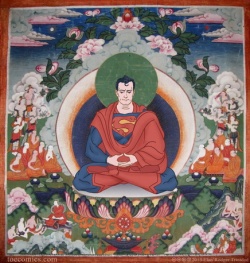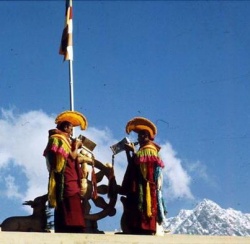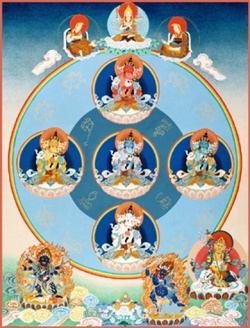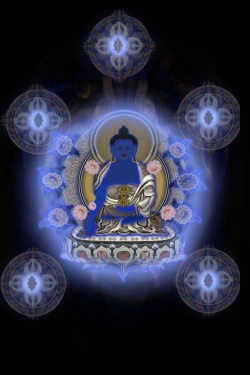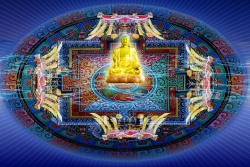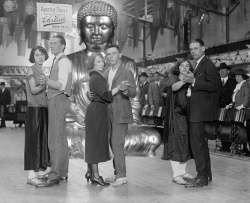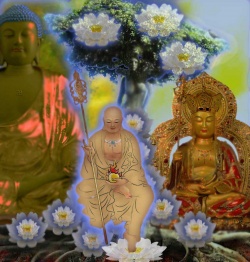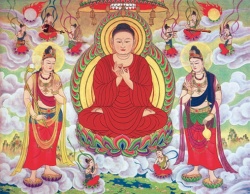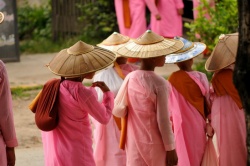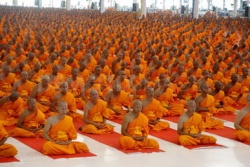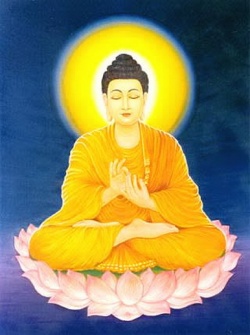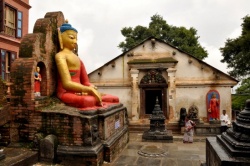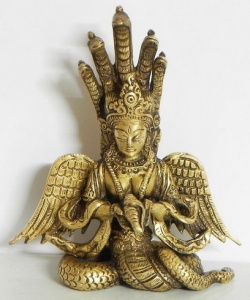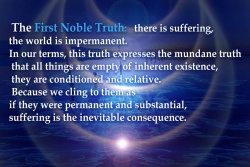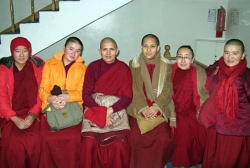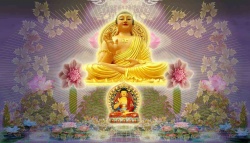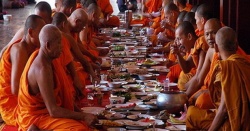Thirty-Seven Factors of Enlightenment
Thirty-Seven Factors of Enlightenment - 37 Dharmas of the Bodhisattvas
A. Phase of Accumulation
· the four states of mindfulness (satipatthana)
· the four abandonments / the four right efforts (sammappadana)
· the four elements of supernatural power / the four roads to power (iddhipada)
B. Phase of Integration
Sub phases: Warming, Summit, Forbearance, the Highest Worldly Point
· the five moral faculties / the five controlling faculties (indriya)
· the five moral powers (bala)
C. Phase of Insight
· seven limbs of enlightenment (bojjhanga)
D. Phase of Cultivation
· The Noble Eightfold Path (atthangika magga)
E. Phase of Complete Accomplishment
A. Phase of Accumulation
Phase of Accumulation represents the efforts that those endowed with mahayana potential have to make in the practice of virtue. The accumulation of virtue serves to make one's mind a suitable vessel in which realisations can arise.
Four States of Mindfulness / Four Trainings in Mindfulness / Four Contemplations
From the Mahayana point of view the result of four mindfulnesses is the realisation of two fold egolessness, the selflessness of self and the selflessness of phenomena.
1. Contemplation of the body (skandha of form)
- Ordinarily, in worldly terms we regard the body as pure and we have fixation on the body as being true or real.
- In the sutrayana (mahayana or bodhisattvayana), the body is regarded as impure.
- Instead of struggling between the purity and impurity of the body, tantra presents the body as manifestation of emptiness.
2. Contemplation of feelings (skandha of feeling)
- Ordinarily, we regard our feelings as pleasant.
- In the sutrayana the feelings are regarded as unpleasant, as suffering.
- In the tantrayana it is not necessary to reject feelings as suffering, yet you should not cling to them by thinking they are pleasant. Instead you should make your feelings into a tool to give birth or enrich your wisdom. For example if one understands that suffering is fear of being afraid one can look at the fear instead of being paranoid about it.
3. Contemplation of the mind (skandha of consciousness)
- Ordinarily we believe our minds are permanent.
- The contemplation of the 37 dharmas of the bodhisattvas involves reflecting on the truth that mental events are impermanent.
- According to the tantrayana, the mind is the wisdom of self-realization; therefore it is unnecessary to struggle between permanence and impermanence of the mind.
4. Contemplation of phenomena / dharmas (skandhas of perception and concept)
- In our ordinary, or mundane, viewpoint, we regard all phenomena as real or solid; therefore we believe in the existence of self.
- In accordance with the 37 dharmas, phenomena have no concrete, solid identity and they are selfless.
- In the tantrayana, all phenomena are presented as being the union of skilful means and wisdom, and this understanding goes beyond the struggle between substantiality or insubstantiality, or having or lacking a self.
Through mindfulness of body we realise the truth of suffering
Through mindfulness of feeling we realise the truth of the origin of suffering.
Through mindfulness of the mind we realise the truth of cessation.
Through mindfulness of phenomena we realise the truth of the path.
Four Abandonments / Four Right Practices
5. to get rid of existing evils and non-virtues
6. never to give rise to evils and non-virtues that are presently absent
7. to give rise to virtuous remedies not yet present
8. to assure the increase of those virtues which are already developed
Four Elements of Supernatural Power / Four Roads to Power / Four Supports of Miraculous Apparition
9. profound absorption through longing
10. profound absorption through diligence
11. profound absorption through intention
12. profound absorption through analysis
B. Phase of Integration
A breakthrough in understanding which is conducive to realisation of the Four Truths. Integration refers to integration into a direct realisation of truth.
Subphases:
Warming - one first warms to the real meaning of voidness.
Summit - one sees a panoramic view. The earth (defilements) has diminished to a point, whereas space (voidness) becomes more and more present. At peak one stands between heaven and earth, phenomena and voidness.
Forbearance - as an aspiration to certainty about phenomena and the skill needed to face up voidness and its implications.
The Highest Worldly Point - This is the highest point and the end of samsara. After this subphase there will be no more samsaric rebirth. The whole quality of experience will change. The subsequent Phase of Insight has nothing to do with worldliness.
Five (Moral or Controlling) Faculties
13. trust
14. diligence
15. recollection
16. deep absorption
17. profound wisdom
The five faculties are employed during the sub phases of warming and summit. In the sub phases of forbearance and highest worldly point these become five powers.
Five (Moral) Powers
18. the power of trust
19. the power of diligence
20. the power of recollection / mindfulness
21. the power of deep absorption / concentration
22. the power of profound wisdom
C. Phase of Insight
For the first time one gains authentic insight into the Truths of the Realised. There are four aspects for each truth, 16 altogether. For example having understood the suffering of the sense dimension of existence one furthers this understanding to incorporate the sufferings of the form and formless dimensions. During that stage one is endowed with seven aspects of enlightenment.
Seven Limbs or Aspects of Enlightenment
23. right mindfulness
24. right discerning appreciation / investigation
25. right diligence / energy
26. right joy / interest
27. right proficiency / tranquillity
28. right profound absorption / concentration, one-pointedness
29. right equanimity / elimination of mind's tendency to wander
D. Phase of Cultivation
One cultivates familiarity with meditation which rests within the universal essence realised through the Phase of Insight. During this stage one is endowed with the Noble Eightfold Path which is based upon right view. This is the first of the eight and the remaining seven represent the pure way in which something of this sublime view can be communicated to others through concepts and examples.
30. right view
31. right intention
32. right expression
33. right limits of action
34. right livelihood
35. right effort
36. right mindfulness
37. right profound absorption
E. Phase of Complete Accomplishment
When the training has been completed there are ten qualities without training. They are the eight qualities of the eightfold path plus total liberation and immaculate primordial wisdom. These ten factors form five groups of untainted aggregates:
1. right conduct
- training-free right expression,
- training-free right action
- training-free right livelihood.
2. profound absorption
- training-free right mindfulness
- training-free right profound absorption
3. highest wisdom
- training-free right view
- training-free right intention
- training-free right effort
4. perfect liberation
- training-free total liberation
5. primordial wisdom insight of total liberation
- training-free immaculate primordial wisdom
Points of difference in the basic Buddhist view (Hinayana) of mindfulness and the Mahayana view:
- In the Mahayana the antidote is to overcome the clinging to a self of a person and phenomena. In the Hinayana path the antidote overcomes only clinging to a self of a person.
- In the Hinayana path one enters alone, in the Mahayana state we do not enter alone but we enter with all sentient beings.
- Through practising the basic mindfulness practice in the Hinayana, the attainment is cessation, the nirvana which is complete state of thoughtlessness, complete state of mindfulness. In the Mahayana the result is the state of enlightenment beyond simple cessation and the notion of nirvana as being peace.
- In the Mahayana path mindfulness is practised in accordance with what is appropriate for all sentient beings and what is appropriate for the whole environment, rather than practising it for the sake of oneself alone.
- In the Mahayana the body is understood as illusory body, feelings are dream-like, mind is like space and phenomena are understood to arise suddenly like clouds.
- The Hinayana arhats leap out of samsara, leave it behind completely. In the Mahayana sense, we attain the power of transcending our emotions even though we constantly come back to the samsaric world to benefit sentient beings. We have attained the power of not being attached to samsaric world even though we live in it. We live with emotions and use them as a path without being attached to our own emotions and without being attacked by them.
- The qualities of a Mahayana practitioner outshine all achievements of any other realisation by the simple seed of bodhicitta. Even though we have done very little practice and as a result our achievement is small, because of the power of courageous heart, love and compassion and the method of being skilful, there is greatness in the achievement.
- The result of the Mahayana path is the ten bhumis or stages of a bodhisattva. We progress through the ten stages and attain Buddhahood at the end of the tenth bhumi. This takes a very long time.
Vajrayana (tantrayana or mantrayana) offers many methods to attain enlightenment more swiftly. Vajrayana practitioners become siddhas instead of arhats or bodhisattvas. The great Indian mahasiddhas are famous for their unconventional behaviour and special methods through which they have liberated beings effectively. Tantric teachings are especially meant for the Dark Age, when other methods are ineffective. In the vajrayana one does not need to deliberately accomplish the ten good actions. The practice of good actions will occur spontaneously from the realization that comes from meditation. Similarly, the ten unvirtuous actions will be spontaneously avoided without any need to deliberately control one’s actions. With the realization of the nature of mind one does not need to have contrived conduct. There will also be no need to deliberately contrive remedial actions, to engender realization through effort. If one rests relaxed in the natural state of the mind, the realization of clarity and emptiness will naturally arise. Vajrayana should be practised under a qualified guru only.
Sources:
Gems of Dharma, Jewels of Freedom. The classic handbook of Buddhism by Jé Gampopa, translated by Ken and Katia Holmes.
Teachings of Dzogchen Ponlop Rinpoche , Khenchen Thrangu Rinpoche and Khenpo Karthar Rinpoche.
see also: The Tree of Enlightenment: An Introduction to the Major Traditions of Buddhism - Chapter Forty: The Thirty-Seven Factors of Enlightenment
